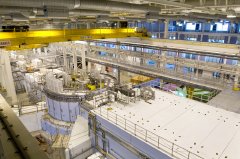Nov 2 2009
The latest SKF rolling bearings and condition monitoring systems are playing a vital role in maximising the uptime of specialised precision devices used in the ISIS neutron and muon source at the Rutherford Appleton Laboratory in Oxfordshire. In particular, the SKF bearings provide a unique combination of reliability and precision, on motor driven shafts rotating at up to 6,000 rpm and balanced to speeds that are controlled to within ±5 microseconds, while the condition monitoring systems ensure continuous measurement of critical operating parameters.

The Rutherford Appleton Laboratory is a world-leading scientific research centre, with ISIS being one of a number of facilities on the site. The ISIS system generates streams of neutrons, which are then used to bombard samples of, for example, engineering materials, enabling scientists to learn more about their properties at a subatomic level.
The production of neutrons begins with an ion source, with a stream of negatively charged ions being fed into a sequence of three accelerators. The first two accelerators focus and speed up the ions, with the final synchrotron being used to strip away unwanted electrons leaving a beam of protons separated into two pulses travelling at 84% of the speed of light. The proton pulses are subsequently directed down one of two beam lines to two separate Target Stations, where they strike solid tungsten rods, causing neutrons to be driven off from the nuclei of the tungsten atoms.
Neutrons are emitted from the target in a series of intense pulses, which are directed down multiple beamlines, arranged like spokes of a wheel around each Target Station. At the head of each beamline are dedicated instruments used for particular scientific experiments.
Target Station 1 has been in operation for some 20 years, while Target Station 2 has recently opened to provide both increased capacity and new opportunities for research using low energy neutrons, which are ideal for investigating the properties of soft matter, advanced composites and materials used in bio-sciences.
Peter Galsworthy, Senior Design Engineer for the ISIS Engineering Group, explains that, "Neutron pulses last just 1/50th of a second and contain a sequence of individual neutrons, each of which has a unique energy and wavelength. These have to be separated to meet the specific needs of each instrument; for example, one experiment might require high energy neutrons, while another needs only low energy neutrons".
Separating each pulse is an extremely challenging operation and is achieved using rotating neutron choppers or rotors, spinning at speeds of up to 6,000rpm, and synchronised precisely with the frequency of each pulse, normally to within ±5µsecs. Each rotor has either boron coated blades to adsorb neutrons or machined orifices to allow neutrons to pass through.
Peter Galsworthy adds, "Each rotor shaft is powered by a direct drive motor, with an encoder and SKF rolling bearings fitted on either side of the rotor, providing almost frictionless and perfectly balanced shaft alignment. SKF bearings are used exclusively as they are reliable and produce consistent, predictable results over time, even under extreme operating conditions. For example, the ball bearing races are under considerable load and have to function without slipping, while each roller bearing assembly has to accommodate thermal expansion of the rotor shaft caused by the heat from windage effects".
In addition, each bearing and shaft assembly is continuously monitored by means of accelerometers and thermocouples connected to SKF's networked Multilog control units. These intelligently monitor the neutron choppers, retrieving data only when they are operating within certain parameters, or when an alarm state is activated, with information being fed to SKF's powerful @ptitude condition monitoring software. This gives engineers instant access to live and historical data, with automated diagnostics and detailed trend analyses for predictive maintenance being overlaid on SKF's comprehensive database of bearing operating parameters, drawn from applications throughout the world.
Peter Galsworthy concludes, "The ISIS system is in almost constant operation, running 24/7 during production cycles of up to 45 days, with instruments being in constant demand from scientists around the world. Unplanned downtime can cost £30,000 a day in lost revenues, so reliability and continuous system monitoring are critical. The team from SKF has played an important role in helping us achieve optimum levels of uptime, both through the provision of reliable, high quality products and technology, and by providing outstanding long term technical support."